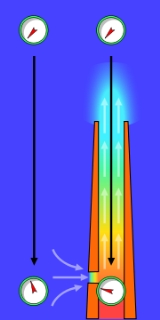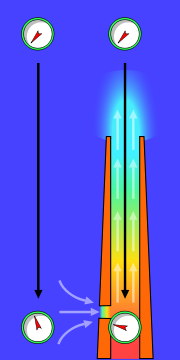
Stack effect
Encyclopedia
Stack effect is the movement of air into and out of buildings, chimneys, flue gas stacks, or other containers, and is driven by buoyancy
. Buoyancy occurs due to a difference in indoor-to-outdoor air density resulting from temperature and moisture differences. The result is either a positive or negative buoyancy force. The greater the thermal difference and the height of the structure, the greater the buoyancy force, and thus the stack effect. The stack effect is also referred to as the "chimney effect", and it helps drive natural ventilation
and infiltration
.
In a modern high-rise building with a well-sealed envelope
, the stack effect can create significant pressure differences that must be given design consideration and may need to be addressed with mechanical ventilation
. Stairwells, shafts, elevators, and the like, tend to contribute to the stack effect, whereas interior partitions, floors, and fire separations can mitigate it. Especially in case of fire, the stack effect needs to be controlled to prevent the spread of smoke.
 The stack effect in industrial flue gas stacks is similar to that in buildings, except that it involves hot flue
The stack effect in industrial flue gas stacks is similar to that in buildings, except that it involves hot flue
gases having large temperature differences with the ambient outside air. Furthermore, an industrial flue gas stack typically provides little obstruction for the flue gas along its length and is, in fact, normally optimized to enhance the stack effect to reduce fan energy requirements.
Large temperature differences between the outside air and the flue gases can create a strong stack effect in chimneys for buildings using a fireplace for heating. Fireplace chimneys can sometimes draw in
more cold outside air than can be heated by the fireplace, resulting in a net heat loss.
For flue gas stacks and chimneys, where air is on the outside and combustion flue gases are on the inside, the equations will only provide an approximation and h is the height of the flue gas stack or chimney.

For flue gas stacks or chimneys, where air is on the outside and combustion flue gases are on the inside, the equation will only provide an approximation. Also, A is the cross-sectional flow area and h is the height of the flue gas stack or chimney.

Also, this equation is only valid when the resistance to the draft flow is caused by a single orifice characterized by the discharge coefficient C. In many, if not most situations, the resistance is primarily imposed by the flue stack itself. In these cases, the resistance is proportional to the stack height H. This causes a cancellation of the H in the above equation predicting Q to be invariant with respect to the flue height.
Buoyancy
In physics, buoyancy is a force exerted by a fluid that opposes an object's weight. In a column of fluid, pressure increases with depth as a result of the weight of the overlying fluid. Thus a column of fluid, or an object submerged in the fluid, experiences greater pressure at the bottom of the...
. Buoyancy occurs due to a difference in indoor-to-outdoor air density resulting from temperature and moisture differences. The result is either a positive or negative buoyancy force. The greater the thermal difference and the height of the structure, the greater the buoyancy force, and thus the stack effect. The stack effect is also referred to as the "chimney effect", and it helps drive natural ventilation
Natural ventilation
Natural ventilation is the process of supplying and removing air through an indoor space without using mechanical systems. It refers to the flow of external air to an indoor space as a result of pressure or temperatures differences. There are two types of natural ventilation occurring in...
and infiltration
Infiltration (HVAC)
Infiltration is the unintentional or accidental introduction of outside air into a building, typically through cracks in the building envelope and through use of doors for passage. Infiltration is sometimes called air leakage. The leakage of room air out of a building, intentionally or not, is...
.
Stack effect in buildings
Since buildings are not totally sealed (at the very minimum, there is always a ground level entrance), the stack effect will cause air infiltration. During the heating season, the warmer indoor air rises up through the building and escapes at the top either through open windows, ventilation openings, or other forms of leakage. The rising warm air reduces the pressure in the base of the building, drawing cold air in through either open doors, windows, or other openings and leakage. During the cooling season, the stack effect is reversed, but is typically weaker due to lower temperature differences.In a modern high-rise building with a well-sealed envelope
Building envelope
The building envelope is the physical separator between the interior and the exterior environments of a building. Another emerging term is "Building Enclosure". It serves as the outer shell to help maintain the indoor environment and facilitate its climate control...
, the stack effect can create significant pressure differences that must be given design consideration and may need to be addressed with mechanical ventilation
Ventilation (architecture)
Ventilating is the process of "changing" or replacing air in any space to provide high indoor air quality...
. Stairwells, shafts, elevators, and the like, tend to contribute to the stack effect, whereas interior partitions, floors, and fire separations can mitigate it. Especially in case of fire, the stack effect needs to be controlled to prevent the spread of smoke.
Stack effect in flue gas stacks and chimneys

Flue
A flue is a duct, pipe, or chimney for conveying exhaust gases from a fireplace, furnace, water heater, boiler, or generator to the outdoors. In the United States, they are also known as vents and for boilers as breeching for water heaters and modern furnaces...
gases having large temperature differences with the ambient outside air. Furthermore, an industrial flue gas stack typically provides little obstruction for the flue gas along its length and is, in fact, normally optimized to enhance the stack effect to reduce fan energy requirements.
Large temperature differences between the outside air and the flue gases can create a strong stack effect in chimneys for buildings using a fireplace for heating. Fireplace chimneys can sometimes draw in
Infiltration (HVAC)
Infiltration is the unintentional or accidental introduction of outside air into a building, typically through cracks in the building envelope and through use of doors for passage. Infiltration is sometimes called air leakage. The leakage of room air out of a building, intentionally or not, is...
more cold outside air than can be heated by the fireplace, resulting in a net heat loss.
The driving force for the stack effect
There is a pressure difference between the outside air and the air inside the building caused by the difference in temperature between the outside air and the inside air. That pressure difference ( ΔP ) is the driving force for the stack effect and it can be calculated with the equations presented below. The equations apply only to buildings where air is both inside and outside the buildings. For buildings with one or two floors, h is the height of the building. For multi-floor, high-rise buildings, h is the distance from the openings at the neutral pressure level (NPL) of the building to either the topmost openings or the lowest openings. Reference explains how the NPL affects the stack effect in high-rise buildings.For flue gas stacks and chimneys, where air is on the outside and combustion flue gases are on the inside, the equations will only provide an approximation and h is the height of the flue gas stack or chimney.

- SI unitsSiSi, si, or SI may refer to :- Measurement, mathematics and science :* International System of Units , the modern international standard version of the metric system...
:
| where: | |
| ΔP | = available pressure difference, in Pa Pascal (unit) The pascal is the SI derived unit of pressure, internal pressure, stress, Young's modulus and tensile strength, named after the French mathematician, physicist, inventor, writer, and philosopher Blaise Pascal. It is a measure of force per unit area, defined as one newton per square metre... |
|---|---|
| C | = 0.0342 |
| a | = atmospheric pressure, in Pa |
| h | = height or distance, in m |
| To | = absolute outside temperature, in K Kelvin The kelvin is a unit of measurement for temperature. It is one of the seven base units in the International System of Units and is assigned the unit symbol K. The Kelvin scale is an absolute, thermodynamic temperature scale using as its null point absolute zero, the temperature at which all... |
| Ti | = absolute inside temperature, in K |
- U.S. customary units:
| where: | |
| ΔP | = available pressure difference, in psi |
|---|---|
| C | = 0.0188 |
| a | = atmospheric pressure, in psi |
| h | = height or distance, in ft |
| To | = absolute outside temperature, in °R |
| Ti | = absolute inside temperature, in °R |
The flow induced by the stack effect
The draft or draught flow rate induced by the stack effect can be calculated with the equation presented below. The equation applies only to buildings where air is both inside and outside the buildings. For buildings with one or two floors, h is the height of the building and A is the flow area of the openings. For multi-floor, high-rise buildings, A is the flow area of the openings and h is the distance from the openings at the neutral pressure level (NPL) of the building to either the topmost openings or the lowest openings. Reference explains how the NPL affects the stack effect in high-rise buildings.For flue gas stacks or chimneys, where air is on the outside and combustion flue gases are on the inside, the equation will only provide an approximation. Also, A is the cross-sectional flow area and h is the height of the flue gas stack or chimney.

- SI unitsSiSi, si, or SI may refer to :- Measurement, mathematics and science :* International System of Units , the modern international standard version of the metric system...
:
| where: | |
| Q | = stack effect draft/draught flow rate, m³/s |
|---|---|
| A | = flow area, m² |
| C | = discharge coefficient (usually taken to be from 0.65 to 0.70) |
| g | = gravitational acceleration Standard gravity Standard gravity, or standard acceleration due to free fall, usually denoted by g0 or gn, is the nominal acceleration of an object in a vacuum near the surface of the Earth. It is defined as precisely , or about... , 9.81 m/s² |
| h | = height or distance, m |
| Ti | = average inside temperature, K |
| To | = outside air temperature, K |
- U.S. customary units:
| where: | |
| Q | = stack effect draft/draught flow rate, ft³/s |
|---|---|
| A | = area, ft² |
| C | = discharge coefficient (usually taken to be from 0.65 to 0.70) |
| g | = gravitational acceleration, 32.17 ft/s² |
| h | = height or distance, ft |
| Ti | = average inside temperature, °R |
| To | = outside air temperature, °R |
Also, this equation is only valid when the resistance to the draft flow is caused by a single orifice characterized by the discharge coefficient C. In many, if not most situations, the resistance is primarily imposed by the flue stack itself. In these cases, the resistance is proportional to the stack height H. This causes a cancellation of the H in the above equation predicting Q to be invariant with respect to the flue height.

